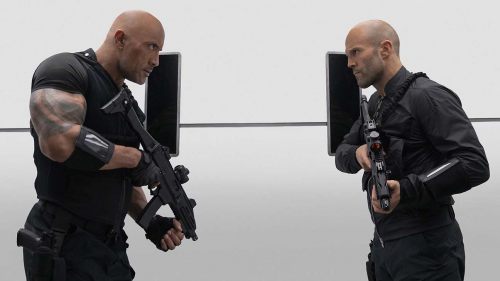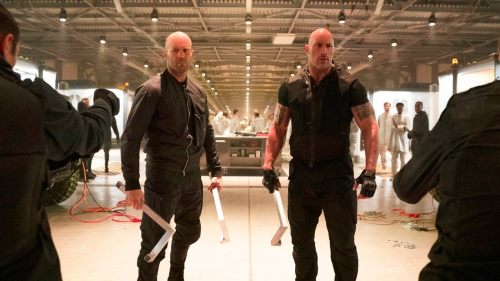The Weird Miracle Of The FAST & FURIOUS Films
Whenever life gets you down, whenever you face some Herculean task that seems impossible to accomplish, whenever you need to believe in miracles if only for a moment, remember the Fast & Furious series. Against many odds, it is out there. And against even more odds, it remains incredible. In fact, it tends to get better as it continues.
The Fast & Furious series has always enjoyed a fanbase, but for many of us it took a while to see what was really going on within these supposedly dumb movies about goofball street racers. By the time Fast Five finally connected all that had come before in an Ocean’s Eleven-esque heist film and took over the world, everyone was pretty much onboard. But the real clue came between films three and four (Tokyo Drift and Fast & Furious), when the series introduced a bizarre line of chronology with which the films are only just now catching up.
Taking place in Japan and with no familiar characters from the previous two films, Tokyo Drift offers the series its most “in name only” entry. But what should just be a useless cash-in movie becomes so much more thanks to this series’ weird magic. Tokyo Drift introduces Sung Kang’s cool-as-ice character, Han, a sort of mentor figure to Lucas Black’s ex-pat racer Sean Boswell. Through Han’s charisma, we slowly learn to accept this movie for what it offers instead of shooting it with shade for using the Fast & Furious title when there’s no sign of Vin Diesel or Paul Walker (well, almost no sign anyway). Then - spoilers, by the way! - the film kills Han, solidifying this whole story as a one-and-done entry.
Except that’s not what happens. A few years later, Fast & Furious comes out. And hey! There’s Han! So now we know that whatever happens, these next films take place chronologically before Tokyo Drift so long as Han remains alive. That is not normal. It’s seriously awesome, but it’s not normal.
They say you can’t have your cake and eat it too. Yet this Han business offers a perfect example of how the Fast & Furious series manages to pull it off all the time. This chronology trick serves a cynical movie business purpose because it artificially lends Fast & Furious more of a character everyone loved. It’s the kind of thing that tends to ruin the credibility of movies like this. You liked Joe Pesci in Lethal Weapon 2? Now he’s shoehorned into every sequel until you cringe just looking at him.
But that’s not how it works with Fast & Furious. By getting to know Han better and seeing the adventures leading up to his death, we now have an even better character to love and a new and enriched version of Tokyo Drift to enjoy. The supposedly one-and-done, superfluous entry now has vitality and emotional depth that was impossible when it first arrived, and it was already pretty entertaining to begin with.
And that supplies us with another area in which the Fast & Furious films defy expectations. Seen as a saga, they achieve maximum pop-fun, yet each entry can boast its own quality as an individual film. Consensus points to the fourth entry, Fast & Furious, as a series low, and that film still has all kinds of great stuff in it - the big desert chase, Dom and Brian’s street race and especially the scene in which Dom magically pieces together Letty’s death by reading tire treads at the week-old crash site. Despite some problems (its dour tone keeps it from being as fun as the others), the film remains far more enjoyable than most series’ fourth entries.
Partially because no one really wove this strange narrative tapestry on purpose, each entry really gets to have its own identity. There’s the original film, a fun Point Break retread. This is followed by 2 Fast 2 Furious, a colorful, extremely goofy romp that trades Dom’s tight-knit family for a look at Florida’s street racing culture as a family in and of itself. Tokyo Drift focuses more than ever on the actual racing as well as the series’ peaceful and friendly insistence on progressive cultural perspectives. Fast & Furious, a kind of dry-run at what the series would accomplish in Fast Five, brings Dom and Brian back together to take down a drug dealer and finally solidifies Brian’s choice to follow family over the law. All these films have their own feel and flavor. What other series can you think of that lacks its lead character for two entries, yet uses that absence (accurately, if accidentally) as an opportunity to expand its narrative scope?
Nevertheless, one can’t deny a feeling of division between the series’ pre and post-Fast Five entries. That doesn’t mean it’s all mediocre nonsense until the celebrated fifth film, however. Fast Five would not work as well as it does without the films preceding it. They don’t dishonestly shift any elements to fit a new larger picture. The Roman we meet here is the same comedy relief goofball we met in 2 Fast 2 Furious. Tej’s stance as the crew’s tech guy makes total sense based on what we’ve already seen of him. Dom’s overly sentimental focus on family was present way back in the first film. We’ve already seen these guys work for and against the law, so seeing them do both at the same time presents little problem. Furthermore, the later films don’t just cull popular characters for the kick it gives audiences. Fast Five brings back Matt Schulze as the first film’s mostly forgotten Vince. Fast & Furious 6 re-introduces Fast & Furious antagonist Arturo Braga. No one asked to see these characters again, but their inclusion fortifies the long-form storytelling at play.
With such a varied and robust mythology on which to capitalize, it is perhaps not so surprising that Fast Five provides such a great series culmination. But once you play that card, where do you go next? Director Justin Lin and writer Chris Morgan appeared to crack the Fast & Furious code, but that can only work once. Realistically, another sequel should merely bore us by copying that formula or anger us by screwing it up.
Somehow, that’s not what happened. Fast & Furious 6 manages to heighten everything that worked in Fast Five without delivering a mere Xerox of what came before. It does so by taking the characters we love and subtly transplanting them into a different action sub-genre. While Fast Five is a thrilling heist film, Fast & Furious 6 is a total comic book movie.
This is not so different from what Marvel (the Fast & Furious series’ closest counterpart) does with their films. All technically belong to the comic book genre, yet THOR offers crazy fantasy elements, while Captain America: The Winter Soldier models itself after ‘70s political conspiracy thrillers. By shifting genre focus, Fast & Furious 6 places a team we’re already fond of into situations we’ve yet to see. So now, instead of dragging a huge vault all over Rio de Janeiro, they’re working as a unit to protect civilians from a murderous villain in a tank. It’s still all based on vehicular stunts, family and deep bromance, so it’s not like anything important gets betrayed by the shift.
And now it looks like the series might pull off yet another weird miracle with Furious 7. The film faces a unique set of challenges. For the first time in four films, a new director, James Wan, is calling the shots. We can already see this change in motion when watching the trailer, which displays a bigger dependency on computer generated visuals than we’re accustomed to from the series. Narratively, our beloved group of characters will have to do without Han or Gisele. And in a much greater and very real off-screen sense, the series’ tight family focus will have to contend with the tragic death of Paul Walker.
But if any series can pull this off, it’s Fast & Furious. Helping Furious 7 along is a narrative based on revenge. Mutual revenge, actually, which makes for an even more interesting spin. The gang needs to get back at Jason Statham for killing Han. Meanwhile, Statham wants to hunt the gang for killing his brother. And speaking of Jason Statham, he offers the series not only a new marquee player but also its first genuinely aggressive and threatening villain, an element the Fast & Furious films tend to lack.
Even if Furious 7 disappoints, the Fast & Furious series would remain a franchise of rare quality and integrity. Few things are as wonderful as finding a gem where you least expect it. Watching this story of fast cars and criminals mutate into an international action epic filled with shifting relationships and emotional losses has been a privilege. Anyone who thinks they are too good to experience the ride misses out on something of great worth and probably deserves to forfeit their clothes to Ludacris and The Rock.
This was originally published in the April issue of Birth.Movies.Death. Furious 7 opens at the Alamo Drafthouse this Friday. Get your tickets here.



